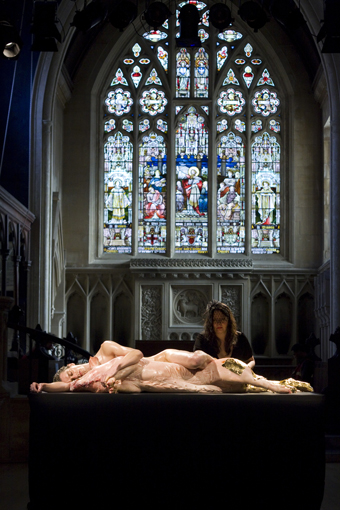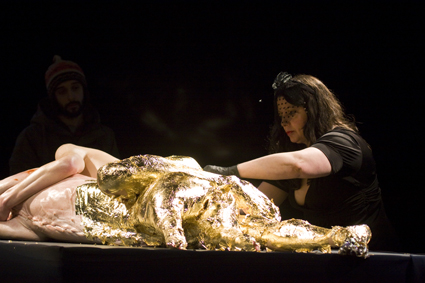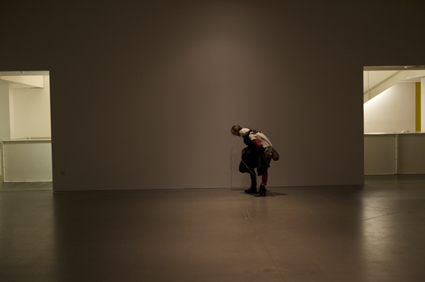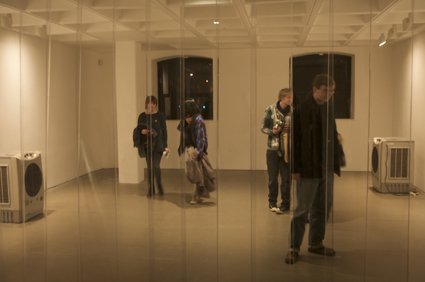 |
Hancok and Kelly Live, Iconographia photo Oliver Rudkin |
hancock & kelly live: iconographia
It was here that Richard Hancock lay on a plinth, at the height of a kitchen worktop, spooning a dead pig. The pig was already in rigor with his legs stretched out, a slight twist cocking his body askew. The man and the pig were the same colour.
Traci Kelly stalked round him purposefully. She was dressed in a black ball gown, a black pillbox hat with a small veil over her eyes, black gloves. Her tools were a block of gold leaf, a folded card to tweezer up each leaf, and a large soft brush, like a make-up brush, to fix and burnish. She would pick up a square of gold leaf delicately, angling it in the breeze of its own movement to minimise creasing and doubling, lay it on one of the bodies and smooth it down with the brush.
By the time I got there, one hour in, the feet and hindquarters of both bodies were covered, and Kelly was moving to the front of the hybrid to pay attention to hips and ribs. Music played: Dido’s Lament from Purcell’s Dido & Aeneas. Shreds of gold leaf escaped from the block, from under the brush, from the bodies, fluttering to the floor round the plinth or sticking to the black gloves and having to be scraped off. Where gold leaf sealed the gap between bodies it kept breaking down and having to be replaced. I kept wanting the process of gilding to be perfect. It stubbornly continued to be messy, very far from perfect.
Hancock held the pig tenderly, one hand resting on its chest between its front trotters. Its legs lay between his and he rested one knee insecurely on its narrow hip. It was a young pig, and thus about one third the man’s size. At all times the combination of genuine gold and glitter, of bourgeois formality (the hat, the gloves, the heels), of the representation of high culture, Purcell, to guarantee the seriousness of the occasion, threatened to topple over into vulgarity. Which is indeed the case at all our most solemn social rituals, weddings and funerals, where the popular, the profane and the high-minded collide.
The man was breathing, the pig was stiff. Both were sinewy and heavily greased with Vaseline. The gold around their nether regions caught the light in a more sparkly, less dense way than did their glowing naked orange-tan-pink skins. The pig had a bruise on its forward ham. The man did not. The man trembled with the cold, or the strain of holding the pose, or because all warmth was being leached out of him into the block of dead meat he cradled.
I had been told the pig still had the grass of its previous happy existence between its toes; I walked round to scrutinise. The long cut that had gutted it formed a tightly sewn, corded seam up the length of its body. Its tongue protruded between its teeth, curving up towards its snout. Smears of blood had been mostly wiped away, leaving only traces under the layer of Vaseline. It was clean. Its eyes were half open—it seemed to be looking up. Hancock lay with his own face directed towards it. He would meet its eyes if he opened his own. Then he did so: they were blue, the same colour as the pig’s. There the two were, in affinity.
At this point I surprised myself—for I don’t have that culturally specific Western sympathy for livestock—by feeling sorry for the pig. Then I felt the ways in which Hancock stood for the pig, and the pig for him, and both of them for all of us, tied to a hunk of dead meat and an inevitable end. The realisation was awful. I had to retreat. I went and sat up in the gallery where all that could reach me was the spectacle. I felt like howling.
 |
Hancock and Kelly Live, Iconographia photo Oliver Rudkin |
More people had come into the church and become slowly rapt, standing closer to the plinth, drawn towards it, fascinated. The golden object, the glittering remnant, was to remain displayed for another half-hour. But I left, not caring to watch Richard Hancock shiver for that length of time. While Kelly was there, she was responsible for the work. But once she had left, audience complicity came into play to give us all control of the spectacle.
 |
Teresa Margolles, 37 Cuerpos photo Carl Newland |
teresa margolles: 37 cuerpos
It seems logical to me to compare Iconographia to Teresa Margolles’ work, not least because the spectacular aesthetic in which Iconographia wallows is so at odds with the minimalist aesthetic of Margolles.
In 37 Cuerpos a gallery space is bisected by a thread running from wall to wall. It is a little below waist height. The room has four entrances/exits, a pair on each side of the cord, at right angles to it, and an adjacent pair in one of the walls to which the cord is fixed, opening into a corridor. The lighting is subdued and the gallery’s plainness underlines the clinical air of the installation.
Closer inspection of the thread reveals details. It is composed of many lengths of a waxy, cat gut-like material knotted together. The sections vary in the degree of blemish they have picked up: rust-coloured, grimy-looking stains. The knots are angular, giving the thing a look of organic barbed wire. The program notes explain each length was used to sew up a body after autopsy. A couple of lengths are heavily stained indeed: that person’s end must have been grisly.
Nobody who ventures into this room steps over the thread to get to the adjoining gallery, although it would be easy to do so. Instead they walk down the line to where the two doors open into the corridor; exit from one, take two paces and re-enter from the other. Then they walk up the line again.
 |
Teresa Margolles, Aire photo Carl Newland |
teresa margolles: aire
In Aire, Margolles’ work in the adjoining gallery, disinfected water collected from the washing of bodies humidifies a room. Those who walk there breathe it in and feel it cooling on their skin. I got to the entrance, hung with a heavy plastic strip door, where I caught a hint of pleasant coolness, as enticing for someone from the tropics as the smell of fresh bread baking. I noticed the industrial humidifier on the floor. I did not go in.
It is the spectators’ responsibility to pay attention, to leave themselves open to engage with the work. That may be all that is required, or they may be challenged by the artist to be complicit in what takes place; or they may be placed in a compromising position without their consent. However, in offering attention, the spectator also claims the freedom to refuse to take part. Once the artist asks for engagement they must also be ready for and accept refusal. Otherwise the quality of the encounter they have arranged is in question (what is real and what is not is always an issue in live work): their request is a sham, an underhand attempt to force a result using the contextual authority of the gallery.
Something more interesting is going on with Margolles, who uses not only the authority of the gallery but the entire machinery of prestige and commodification driving international high culture to draw attention to real lives and deaths in Mexico. As a conscientious spectator I could accept complicity, but I don’t: I am not part of that high culture machinery and I don’t think InBetween Time is either. Nothing could compromise me more in this situation than pretending to be so sophisticated that the idea of touching the paraphernalia of death doesn’t horrify me. A value system is being critiqued here, among other things: my naive reaction acknowledges horror at the base of it.
Inbetween Time Festival of Live Art and Intrigue, Hancock & Kelly Live, Iconographia, Circomedia, Dec 5; Teresa Margolles, 37 Cuerpos and Aire, Arnolfini, Dec 1-Feb 6; Dec 1-5, Bristol UK
Our coverage of the 2010 Inbetween Time Festival is a joint venture between RealTime and Inbetween Time Productions
Osunwunmi is an artist living in Bristol. After a long time working in video she is cautiously but optimistically moving into Live Art practice
RealTime issue #101 Feb-March 2011 pg. 24, web
© Osunwunmi ; for permission to reproduce apply to [email protected]








 back
back